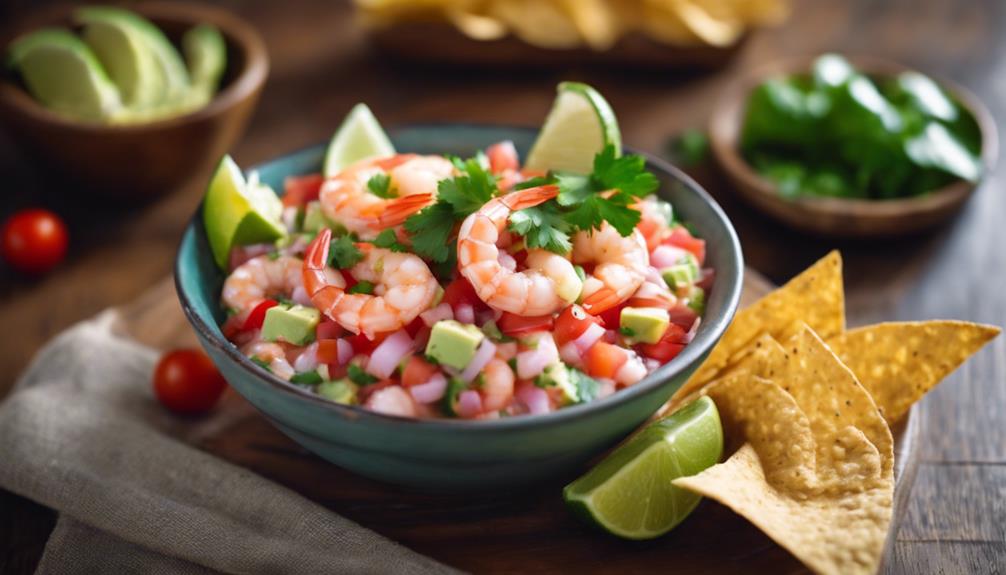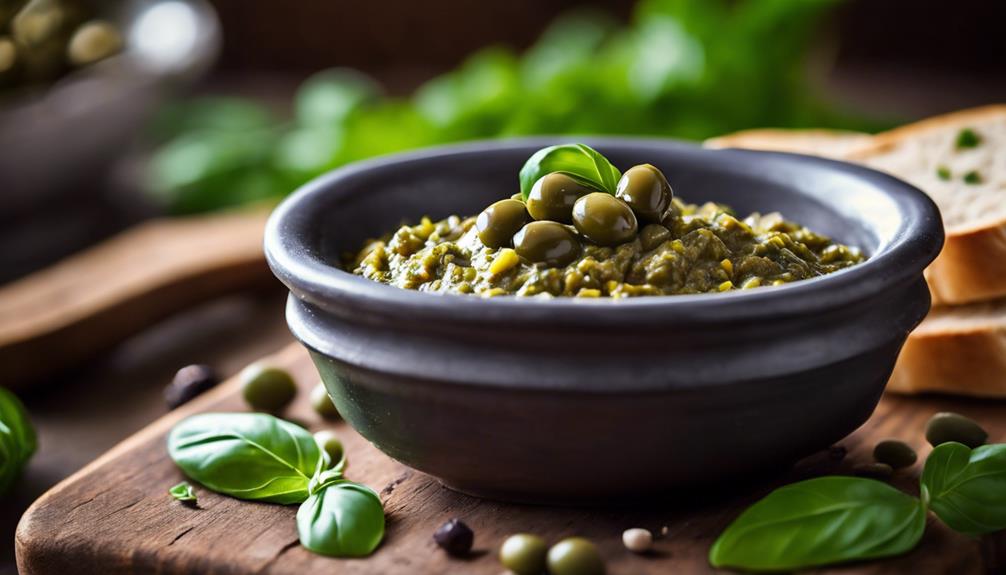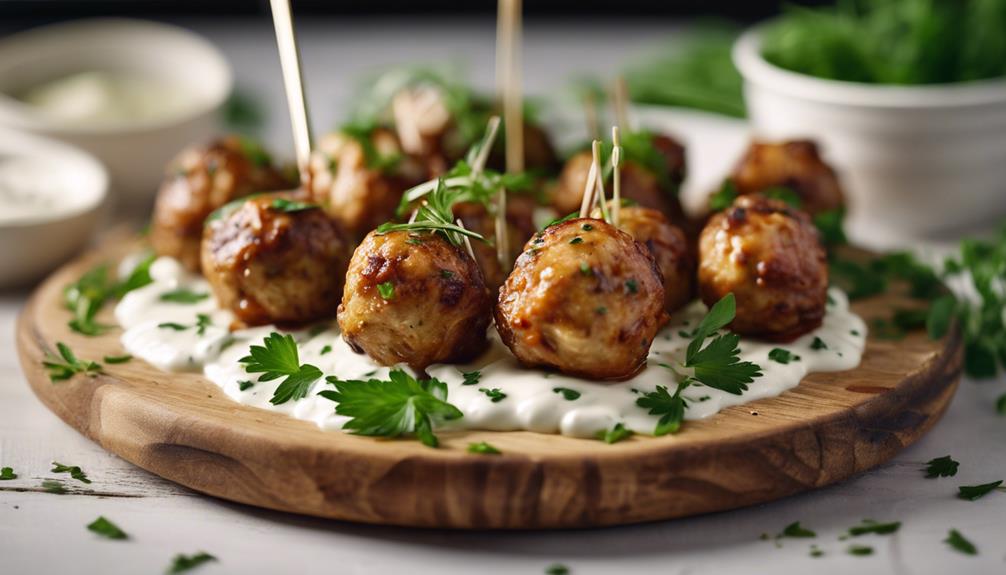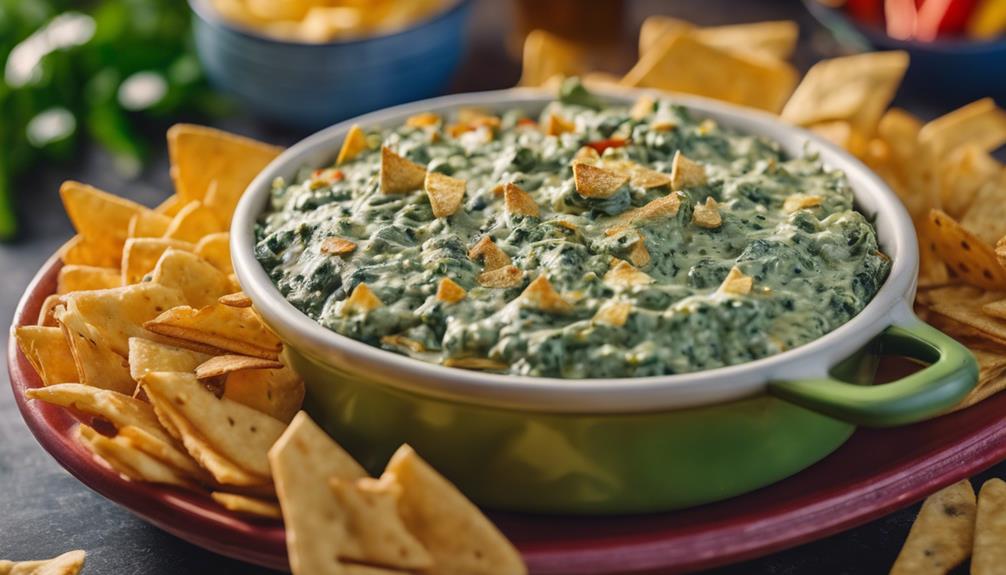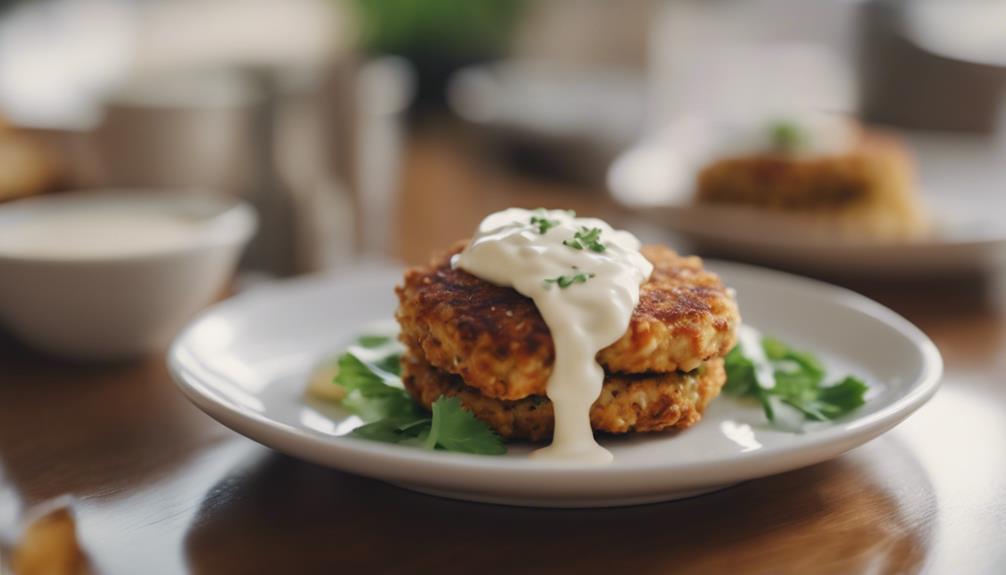Get ready to enjoy Shrimp Ceviche, a mixture of fresh lime juice, tender shrimp, red onion, cucumber, avocado, and cilantro for a flavorful appetizer. The lime juice helps to “cook” the shrimp, ensuring safety. Consider using pre-cooked shrimp for an extra layer of precaution. Elevate the dish by adding a dash of parsley before serving for an explosion of taste. Present it in a chilled bowl alongside tortilla chips or pita chips. For a sophisticated touch, pair it with white wine or sangria. Learn more about different flavor combinations, preparation suggestions, and storage tips to perfect your Shrimp Ceviche experience.
Key Takeaways
- Shrimp ceviche is a fresh and zesty appetizer showcasing raw shrimp marinated in lime juice.
- Quick and easy preparation makes it perfect for light meals or gatherings.
- Customize with ingredients like avocado, red onion, and cilantro for vibrant flavors.
- Serve chilled in a bowl and pair with tortilla or pita chips.
- Experiment with citrus fruits, spices, and peppers to enhance the flavor profile.
Ceviche Origins
Ceviche's beginnings trace back to Peru, where this invigorating dish first emerged in Latin American culinary traditions.
The traditional preparation involves raw seafood, such as shrimp, marinated in citrus juices like lime or lemon, which effectively 'cooks' the seafood through a process called denaturation.
These fresh and zesty flavors have captivated taste buds around the world, leading to various regional adaptations and interpretations of this beloved dish.
One such variation is the Mexican-inspired ceviche, which incorporates ingredients like tomato, avocado, and jalapeño for an added burst of flavor and texture.
While the core elements of ceviche remain constant, the diverse array of ingredients used in different regions creates a delightful tapestry of flavors that cater to various palates.
From the coastal regions of Peru to bustling cities in Mexico, each locale puts its unique spin on ceviche, showcasing the versatility and adaptability of this iconic dish in the domain of global cuisine.
Citrus-Marinated Shrimp
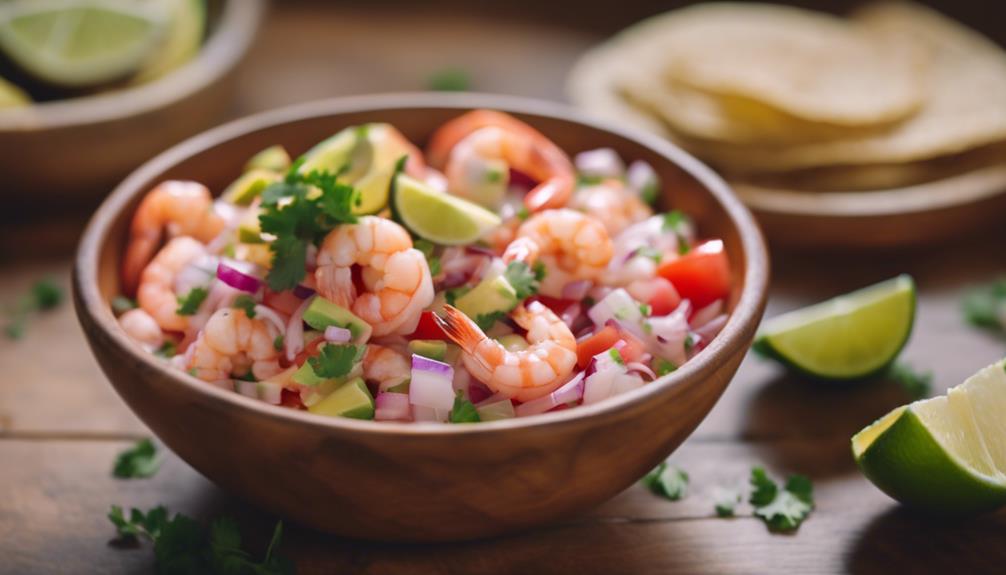
To explore the delightful world of shrimp ceviche, let's now shift our focus to the process of marinating shrimp in citrus juices. When preparing citrus-marinated shrimp for your shrimp ceviche recipe, it is crucial to start with fresh shrimp. The high acidity in lime juice, a key component in marinating the raw shrimp, is what 'cooks' the seafood, giving it a tender texture. This marinating process not only cooks the shrimp but also imparts a zesty flavor that is characteristic of shrimp ceviche. Adding finely chopped red onion to the mix enhances the overall taste profile, creating a seafood appetizer that is both invigorating and tangy. Below is a table illustrating the basic ingredients needed to marinate the shrimp in citrus juices:
| Ingredients | Quantity |
|---|---|
| Raw Shrimp | 1 lb |
| Lime Juice | 1 cup |
| Red Onion | 1/2 cup |
Citrus-marinated shrimp is a crucial step in creating a vibrant and flavorful shrimp ceviche dish.
Colorful Ingredients Mix
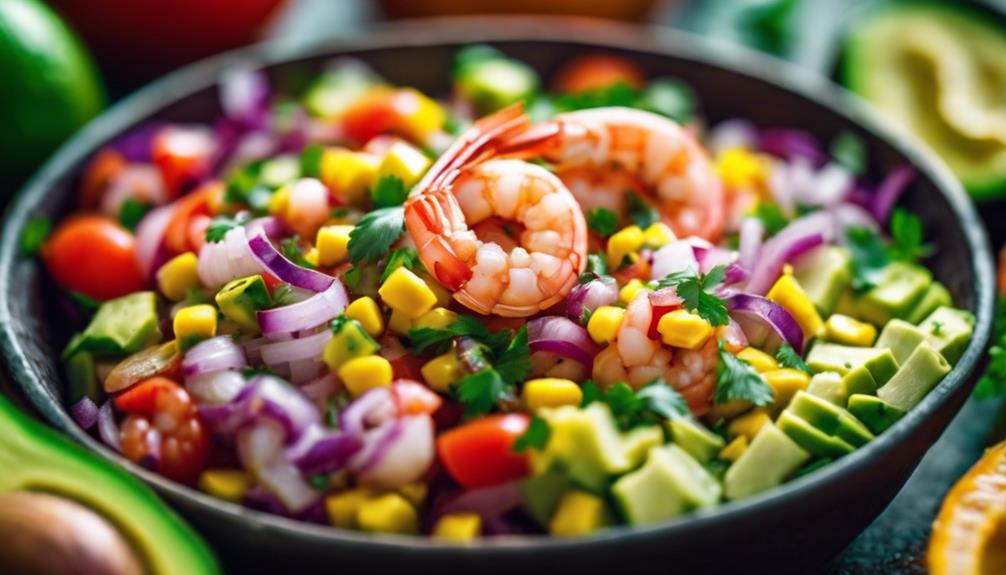
For a vibrant and flavorful shrimp ceviche, consider combining a colorful mix of ingredients such as shrimp, raw citrus juice, red onion, cucumber, tomato, avocado, and cilantro.
To guarantee an extra pop of color and flavor, you can also include red bell pepper cut into small pieces.
When making shrimp ceviche, using pre-cooked shrimp guarantees that the dish is safe to eat without any actual cooking involved.
Once you have mixed all the ingredients together, including the shrimp and vegetables, let it sit in the refrigerator for about 30 minutes to allow the flavors to meld together.
To enhance the presentation and taste, sprinkle some chopped parsley over the ceviche before serving.
This dish pairs wonderfully with crunchy tortilla chips for a satisfying contrast in texture.
Remember to cover the bowl of ceviche while it chills to prevent any flavors from escaping.
Colorful and invigorating, this shrimp ceviche recipe is a delightful addition to your collection of shrimp recipes.
No-Cooking Required Dish
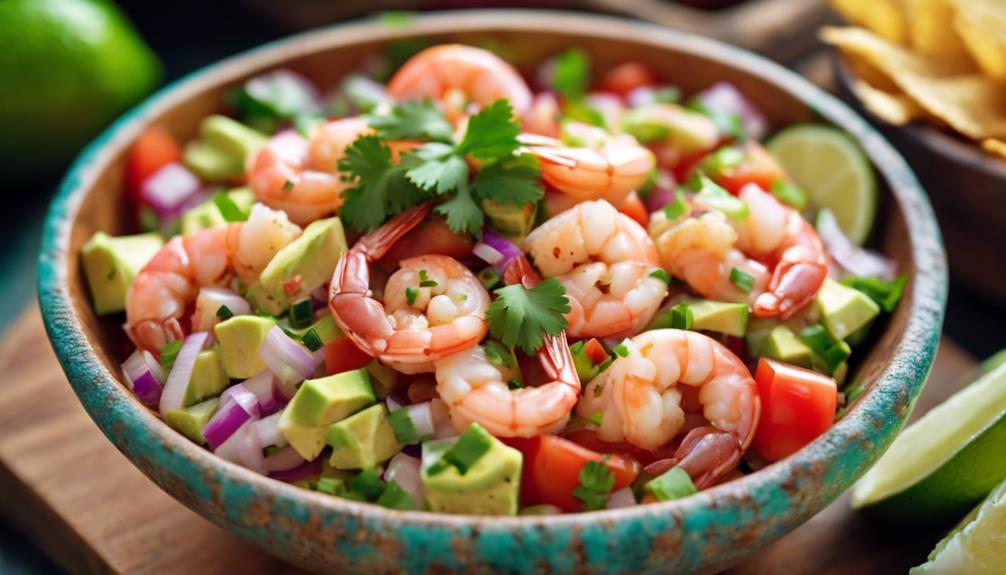
Considered a no-cooking required dish, shrimp ceviche is an invigorating and flavorful option for those seeking a light and zesty appetizer. The beauty of shrimp ceviche lies in its preparation method – the raw shrimp is marinated in citrus juices such as lime, lemon, and orange. The acidity in these juices effectively 'cooks' the shrimp, giving it a deliciously tender texture without ever needing to turn on the stove. This technique not only guarantees a quick and easy dish but also imparts a revitalizing burst of flavors that are perfect for a light meal or appetizer, especially during warm weather.
To make shrimp ceviche, all you need are fresh ingredients like red onion, cucumber, avocado, and a sprinkle of Tajin seasoning for that extra kick. The combination of these raw ingredients with the citrus marinade results in a dish that's both vibrant and satisfying.
Serving Suggestions
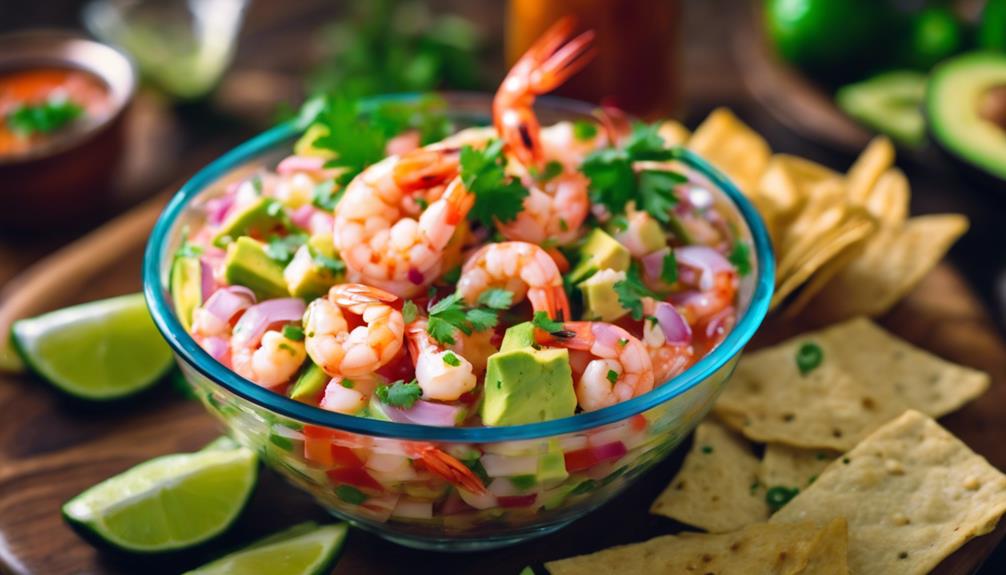
Enhance the dining experience of shrimp ceviche by exploring creative serving suggestions that elevate its flavors and presentation.
When serving this delightful appetizer or light lunch option, consider the following suggestions:
- Serve in a Chilled Bowl:
Presenting shrimp ceviche in a chilled bowl helps maintain its fresh taste and guarantees it stays cool throughout your meal.
- Pair with Crispy Tortilla Chips:
The contrast between the tender shrimp ceviche and the crunch of crispy tortilla chips enhances the overall texture and enjoyment of the dish.
- Try Homemade Pita Chips:
For a unique twist, consider serving shrimp ceviche with homemade pita chips, adding a Mediterranean flair to your dining experience.
- Ideal for Outdoor Gatherings:
Whether hosting a picnic or a gathering in your backyard, shrimp ceviche is a perfect dish to share outdoors with friends and family, thanks to its invigorating flavors and easy-to-serve nature.
These serving suggestions, coupled with a glass of crisp white wine or a refreshing sangria, create the perfect pairing to savor the vibrant colors and zesty flavors of shrimp ceviche.
Make-Ahead Preparation
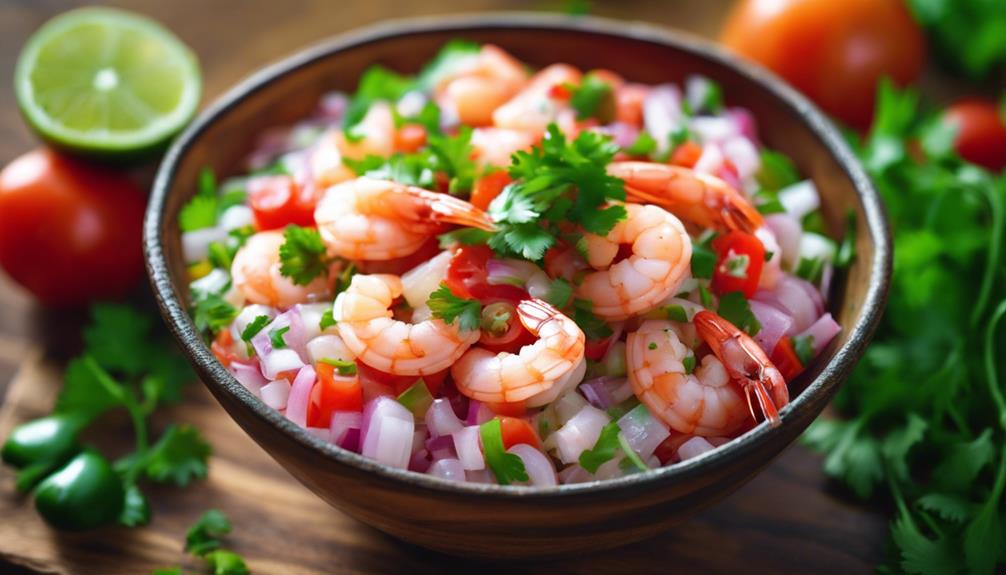
Preparing shrimp ceviche ahead of time allows you to enjoy the convenience of having a fresh and flavorful appetizer ready to serve with minimal effort. By marinating the shrimp in citrus juices and seasonings, the flavors of the ceviche enhance over time, resulting in a more vibrant and delicious dish.
This make-ahead preparation is perfect for those hosting parties, gatherings, or even for a quick and easy weeknight meal. You can prepare the shrimp ceviche up to 12 hours in advance, giving it ample time to absorb all the zesty and tangy marinade flavors.
This not only saves you time on the day you intend to serve it but also guarantees that the dish is at its best when it hits the table. With this convenient preparation method, your shrimp ceviche will be a crowd-pleasing appetizer that's ready to impress without requiring extensive last-minute effort.
Flavor Variations
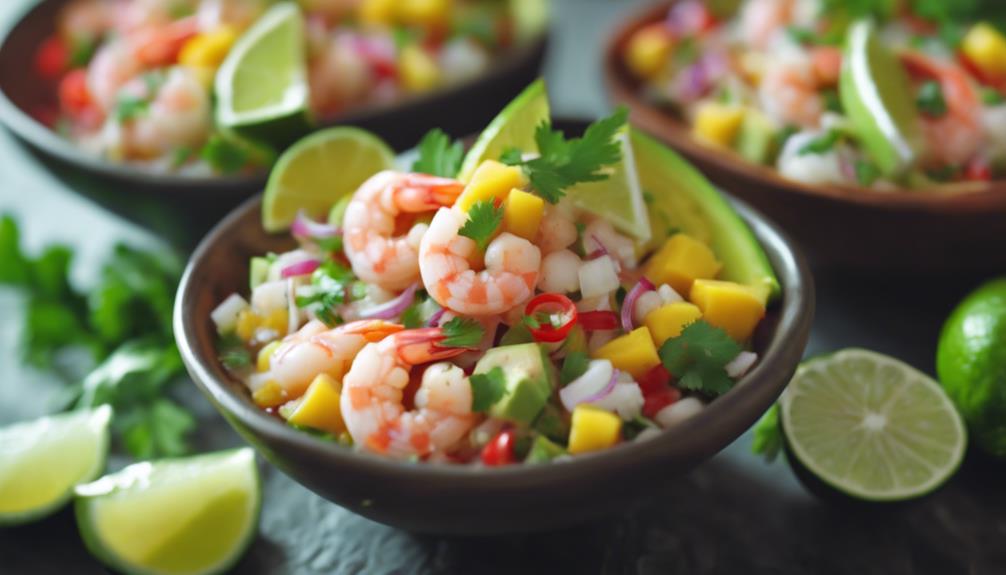
When it comes to flavor variations for shrimp ceviche, you can infuse a burst of freshness by incorporating citrus fruits such as grapefruit or orange juice.
To spice up the taste profile, experiment with seasoning blends like cajun, chipotle, or curry powder.
These additions can elevate the overall experience of your shrimp ceviche, offering a delightful combination of zesty and aromatic flavors.
Citrus Infusion
The versatility of citrus juices in shrimp ceviche allows for a myriad of flavor variations to suit your taste preferences. The citrus infusion, mainly from lime, lemon, and orange juices, plays an essential role in both flavor and texture.
Here are some ways you can customize the flavor profile of your shrimp ceviche:
- Lime Juice: Using lime juice gives a classic tangy and fresh flavor to your ceviche, enhancing the overall zestiness of the dish.
- Lemon Juice: Incorporating lemon juice adds a slightly different citrus note, providing a brighter and more acidic taste to the shrimp.
- Orange Juice: Introducing orange juice can bring a subtle sweetness to the ceviche, balancing out the tanginess and adding depth to the flavors.
- Mixing Citrus Juices: Experimenting with a blend of these citrus juices can create a unique and invigorating twist on traditional shrimp ceviche, offering a harmonious combination of zesty and tangy elements.
Spice Up Flavor
Enhance the vibrancy of your shrimp ceviche by infusing it with a medley of tantalizing flavors.
When making shrimp ceviche, consider adding a citrus juice like grapefruit or orange for a unique twist that will elevate the dish's freshness.
To spice up the flavor profile, try incorporating serrano peppers to give your ceviche a fiery kick that will awaken your taste buds.
For a touch of sweetness, fruits such as mango or pineapple can provide a delightful contrast to the tangy seafood.
You can also customize your ceviche by including vegetables like bell peppers or green onions, adding both texture and flavor to the dish.
To take it a step further, serve your shrimp ceviche with different types of chips or create seafood tostadas for a fun and tasty presentation.
Experimenting with these flavor variations will certainly enhance your shrimp ceviche experience.
Storage Guidelines
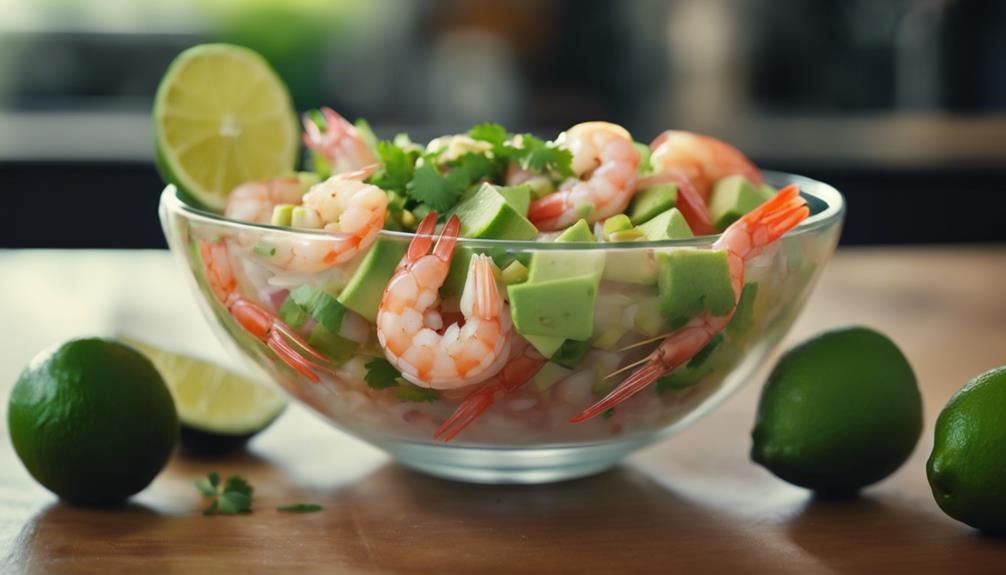
For best freshness and safety, store your shrimp ceviche in an airtight container in the refrigerator. Here are some essential storage guidelines to guarantee your shrimp ceviche remains delicious and safe to eat:
- Consume within 1-2 days: It's recommended to enjoy your shrimp ceviche within this timeframe to maintain its quality and taste.
- Avoid freezing: Freezing shrimp ceviche can alter the texture of the shrimp, impacting the overall dish's flavor.
- Prevent cross-contamination: Keep your shrimp ceviche away from raw seafood or meat to avoid any potential contamination issues.
- Check for spoilage: Before consuming any leftover shrimp ceviche, always inspect it for any signs of spoilage to assure food safety.
Frequently Asked Questions
What Do You Serve Shrimp Ceviche With?
When serving shrimp ceviche, you have various options. You can enjoy it with tortilla chips, tostada shells, or even pita chips. For a lighter choice, serve it on lettuce. To elevate your presentation, consider using individual cups or martini glasses.
Is Ceviche an Entree?
Ceviche isn't typically considered an entree. It's traditionally served as an appetizer to awaken your taste buds and get you ready for the main course. The zesty flavors and citrus-marinated seafood make it a delightful starter.
How Is Ceviche Traditionally Served?
Ceviche is traditionally served as an invigorating appetizer or light snack. Enjoy it with tortilla chips, plantain chips, or on a bed of lettuce. Add avocado, cilantro, or Tajin for extra flavor.
What Is Shrimp Ceviche Made Of?
Shrimp ceviche is made of raw shrimp marinated in citrus juices like lime, lemon, and orange. Additional ingredients include diced red onions, jalapeños, cucumbers, tomatoes, avocado, and cilantro. The acidity 'cooks' the shrimp, creating a zesty flavor.
Can Crab Cakes Be Served as a Refreshing Appetizer Like Shrimp Ceviche?
The classic crab cakes recipe is a versatile dish that can be served as a refreshing appetizer, much like shrimp ceviche. The savory flavors of the crab cakes pair perfectly with a zesty dipping sauce or a light salad, making it an ideal choice for a summertime starter. The classic crab cake appetizer recipe is not only simple to prepare but also offers endless opportunities for customization. From incorporating fresh herbs and spices to experimenting with different dipping sauces, this dish can be tailored to suit any palate. Whether served at an elegant dinner party or a casual backyard gathering, the classic crab cake appetizer recipe never fails to impress with its rich, savory taste and satisfying texture. Its adaptability ensures that the classic crab cakes recipe can seamlessly transition between casual and formal settings, adding a touch of sophistication to any menu. For an extra burst of flavor, try pairing the cakes with a tangy remoulade or a citrus aioli, both of which complement their natural richness. No matter how you serve it, the classic crab cakes recipe effortlessly combines tradition with culinary creativity, making it a go-to dish for any occasion.
Conclusion
To sum up, shrimp ceviche is a delightful and invigorating appetizer that requires no cooking and is bursting with zesty flavors. With its origins in Latin American cuisine, this dish is perfect for any occasion.
By following the simple steps outlined above, you can easily create a colorful and flavorful dish that will impress your guests. So why not give shrimp ceviche a try and add a touch of sophistication to your menu? Your taste buds will thank you.
